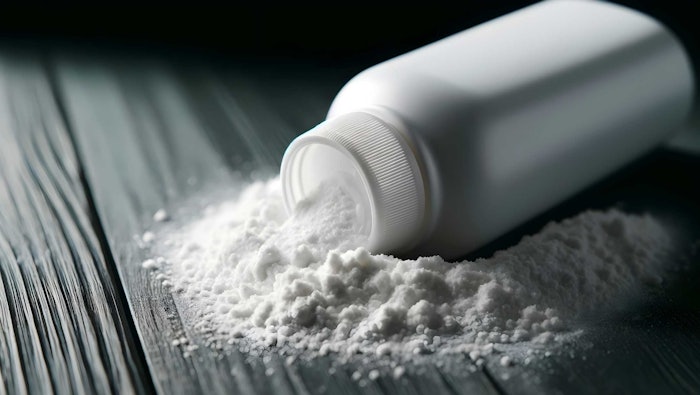
In May, Johnson & Johnson (J&J) offered $6.48 billion to resolve more than 99% of ovarian cancer claims. Last week, we reported J&J settled for $700 million with 42 states and Washington, D.C., that were investigating the company's alleged "misleading" marketing. Now the company faces a new class action seeking damages and medical monitoring, as well as evidence from a recent study "supporting a positive association" between intimate care products including genital talc with ovarian cancer.
Log in to view the full article
In May, Johnson & Johnson (J&J) offered $6.48 billion to resolve more than 99% of ovarian cancer claims. Last week, we reported J&J settled for $700 million with 42 states and Washington, D.C., that were investigating the company's alleged "misleading" marketing. Now the company faces a new class action seeking damages and medical monitoring, as well as evidence from a recent study "supporting a positive association" between intimate care products including genital talc with ovarian cancer.
$6.48 B Offer, $11 B in Reserves and LTL Management Bankruptcy Filing
As reported, in early May 2024, a $6.48 billion settlement was proposed to settle ovarian cancer-related claims through LTL Management, J&J's subsidiary, allowing the company to resolve the lawsuits through a third bankruptcy filing. Those claims account for 99.75% of the talc-related lawsuits filed against J&J, per the company.
This settlement deal only covers the talcum powder claims involving ovarian cancer. J&J has already settled 95% of the talcum power claims involving mesothelioma, according to the Lawsuit Information Center.
Various sources report J&J reserved $11 billion in total (including the $6.48 billion offer) to account for all of its talc settlements, which per Reuters, included "resolving claims outside of bankruptcy proceedings from state attorneys general and individuals alleging asbestos-tainted talc caused their mesothelioma."
Drugwatch adds that in order for this settlement to proceed, it would require three-quarters of the plaintiffs to agree to the offer within 90 days; the vote is on July 26. Bloomberg adds that this 75% threshold is because J&J is seeking a "pre-packaged" bankruptcy "under rules allowing companies to speed through Chapter 11 cases if they have enough creditor support. In bankruptcy court, plaintiffs are converted into unsecured creditors."
$700 M Settlement with the States
As noted, per a June 11, 2024, Reuters report, J&J reached a $700 million talc settlement within the United States over an investigation by 42 states and Washington, D.C. to resolve charges alleging that J&J misled consumers into believing its talc products were safe knowing that they were not. Per Drugwatch, this settlement does not include individual suits involved in the ongoing multidistrict litigation. J&J maintains no wrongdoing.
New Class Action: Damages and Medical Monitoring
In its latest beating, J&J faces a new class action seeking damages and medical monitoring "on behalf of women who have been diagnosed with cancer, or might develop it in the future, allegedly as a result of using the company's baby powder and other products," Fox Business reports.
This would not include the 61,000 individuals who have already filed personal injury lawsuits, per Reuters. The medical monitoring is intended to detect cancer cases early in development in talc users. The suit was filed in a New Jersey federal court on June 17.
Recent Study Finds Talc-Ovarian Cancer Association
Finally, adding insult to injury, in May 2024, a study funded by the National Institute of Environmental Health Sciences (NIEHS) came out in the Journal of Clinical Oncology supporting a "positive association between the use of intimate care products, including genital talc, and ovarian cancer." More specifically, per the authors, the study explored the potential association between intimate care products and female hormone-related cancers, accounting for potential biases, and using data from a U.S.-based cohort study.
"The study analyzed data from a cohort of women who were initially cancer-free who reported their use of intimate care products like genital talc and douching over time," the NIEHS reported. A unique aspect of the study was the use of quantitative bias analysis to account for potential errors in accounts of using intimate care products, the institute noted. It is also is said to be the first of its kind to detail women's use of intimate care products across their life course.
Related to the article, an NIEHS editorial explains that authors O'Brien, et al., observed that both talc-containing genital powder use and douching were associated with ovarian cancer risk even after accounting for multiple bias scenarios. "Given that genital powder use and douching are modifiable exposures potentially associated with a highly fatal disease, [this] data suggest[s] that people at risk for ovarian cancer, particularly those in their 20s and 30s, should be made aware of the potential risks," the authors concluded.
In an interview, Leigh O’Dell, a lawyer from Beasley Allen who co-chairs the plaintiff steering committee, called this a "powerful finding, particularly in a study where prior data didn’t show an increased risk," per Fierce Pharma.
According to the same source, Erik Haas, J&J’s legal chief, stated this study does not change "the overwhelming evidence that talcum powder does not cause ovarian cancer." He added that J&J believes these claims will be dismissed following Daubert review and noted that the study results "do not explicitly establish causality."










